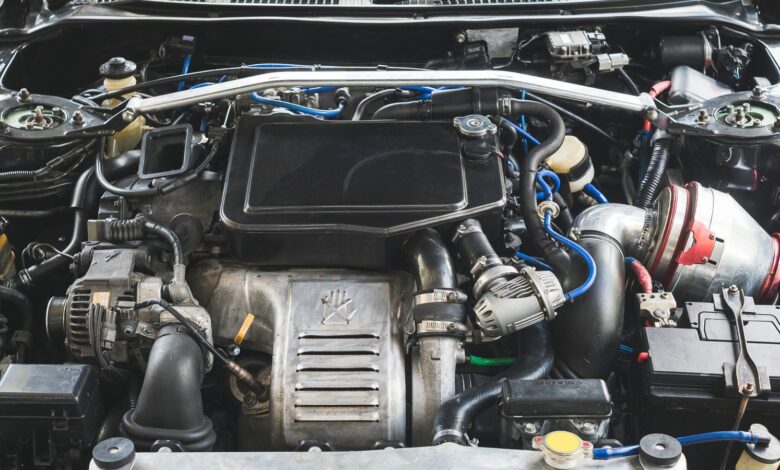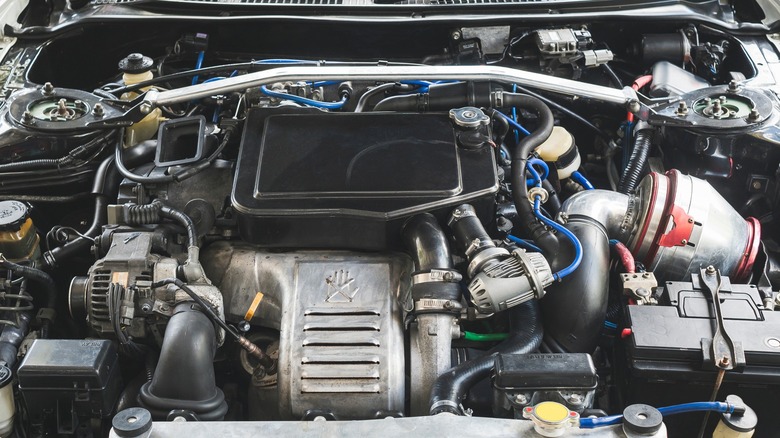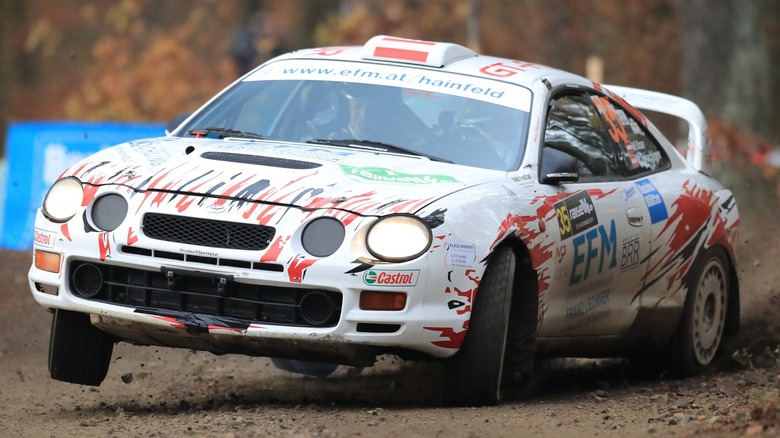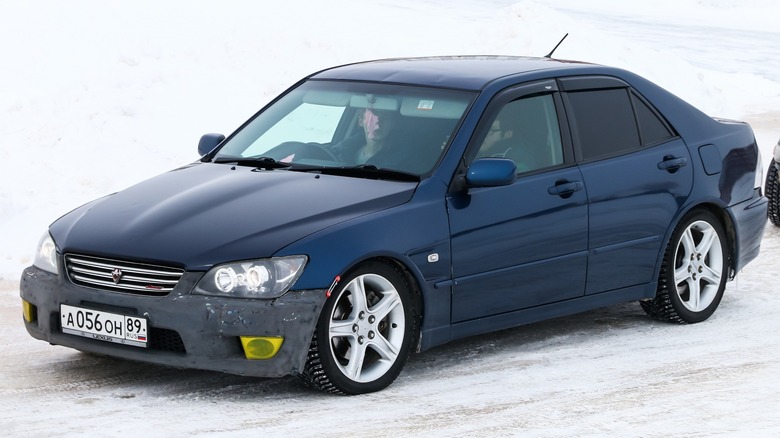5 Underrated Engines That Powered Some Of Toyota’s Coolest Vehicles


Setta Sornnoi/Shutterstock
Calling Toyota an automotive icon almost feels like an undersell at this point. It’s produced some of the most reliable vehicles throughout history, and has staple vehicles through all sorts of disciplines; whether it be high performance, maximum efficiency, or racing.
From the Prius to the Tundra to the Supra, Toyota truly has done it all. However, there are some truly slept-on vehicles throughout the expansive history of Toyota as an automotive manufacturer. Under the hood of those cars are some ferociously underappreciated engines.
Obviously, we’re not pointing fingers at the 1JZ or 2JZ here. If you were to ask anyone who has even slight familiarity with automotive facts to name a Toyota engine, you’re likely going to get one of those two as an answer. In addition, engines like the 4AGE found in the iconic AE86 Toyota Corolla may be a bit more underground than the JZ family, but they are far from underrated as well.
We’re talking about deep cuts, here. With that in mind, here are five engines from Toyota that people tend to overlook, and the cars that they power.
3S-GTE: The infamous rally powerplant

Markus Tobisch/Getty
Before we dig in, let’s review the name structure of Toyota engines. The “S” in 3S-GTE signifies that it is from Toyota’s “S Family” engines. The “G” tells you that it uses a performance dual-overhead-camshaft (DOHC) assembly, the “T” signifies that it’s turbocharged, and the “E” represents electronic fuel injection.
The Toyota 3S-GTE is a 2.0-liter turbocharged inline four-cylinder powerplant that first came to a production car in 1986. With up to 190 horsepower and a matching 190 pound-feet of torque on tap, it made around the same power as a V8-powered Foxbody Ford Mustang of the same year. Over the next three decades and three generations, this punchy turbo four-cylinder eventually grew to output 260 horsepower and 239 pound-feet of torque.
Most notably, you’ll find the 3S-GTE engine under the hood of the Toyota Celica GT-Four — the iconic all-wheel drive rally homologation car. Some devout rally fans may prefer the term “infamous” over “iconic,” though, as the third-generation GT-Four (ST205) was the model banned from WRC Rally racing for cheating. However, the 3S-GTE also powered the Toyota MR2 for certain model years, and even made its way to the Toyota Caldina GT-Four.
1GZ-FE: Toyota’s only V12
Most people don’t think of V12 when they think of Toyota engines, but they did, in fact, make one. The only Japanese mass-produced V12 ever, in fact. The 1GZ-FE BEAMS (Breakthrough Engine with Advanced Mechanism System) is a 5.0-liter V12 engine that Toyota developed solely for its overseas flagship luxury car, the Toyota Century.
With an official 276 horsepower rating, it offered a decent amount of acceleration for this powerhouse of Japanese luxury. However, that was not Toyota’s primary objective with the development of this phenomenal V12 engine. Instead, Toyota’s engineers set sights on producing a low-maintenance and dependable powerplant that was as close to dead-silent as feasible. As a result, engineers designed the engine with a reinforced block.
In addition, the rotating assembly and all other moving components of the engine underwent extreme and precise optimization for a silent ride. The result was an almost unbelievably quiet V12 engine, mated to an equally obsessively engineered transmission and suspension setup, which made the Toyota Century more like a sensory deprivation chamber on wheels than a luxury car.
This engine was developed solely for the Toyota Century, and only ever made its way into that chassis. However, some brave souls have managed to shoehorn this beast into a variety of different chassis and even added turbo power.
[Featured image by Matthias v.d. Elbe via Wikimedia Commons | Cropped and scaled | CC BY 3.0]2ZZ-GE: A Yamaha collab for British sports cars
The ZZ family of engines from Toyota was born in 1997 with the 1ZZ-FE, and it was originally developed with fuel efficiency in mind. However, in 1999, Toyota engineers brought the 2ZZ-GE to the world. As discussed earlier, the “G” in that name is representative of a high-performance dual-overhead camshaft design. Interestingly enough, the cylinder head for the 2ZZ-GE was designed by Yamaha, a company that certainly knows a thing or two about high performance engines.
The 2ZZ-GE made a plenty-spicy 180 horsepower in the U.S.-delivered Toyota Celica GT-S. However, it truly came to life when Lotus adopted it as its powerplant of choice, and added forced induction by way of a supercharger. The Lotus Elise, 2-Eleven, and Exige S used variations of the 2ZZ engine with power output reaching as high as 220 horsepower.
Toyota also took to supercharging the engine, eventually using it for the Toyota Corolla Compressor; an absolutely dream-worthy hot hatchback that, like so many other cool Japanese cars, never made its way to the U.S.
[Featured image by Morio via Wikimedia Commons | Cropped and scaled | CC BY-SA 3.0]3S-GE BEAMS: A high-compression hero

Darthart/Getty
Those getting familiar with the naming structure of Toyota engines will recognize that this engine belongs to the same family as the first engine on this list. This particular engine is indeed a member of the “S Family” and, similarly, has 2.0 liters of displacement and a high-performance DOHC layout.
However, this particular version, the 3S-GE BEAMS is a bit of a rare breed. It was introduced for the 1998 model year, and remained in production through 2005 in the Toyota Altezza. It’s worth noting that the previous-generation 3S-GE engine also got the BEAMS nomenclature, but our focus is specifically on the final iteration that stayed in production until 2005.
The 3S-GE BEAMS represents the enthusiast’s ideal attributes in a lightweight, naturally-aspirated, four-cylinder engine. For a production engine, its 11.5:1 compression ratio is extremely high. It has a dual-camshaft variable valve timing system, and revved out to 7,600 RPM in manual transmission form. When mated to an automatic transmission, the engine got a slightly more tame set of camshafts and “only” revved to 7,000 RPM.
The manual and automatic versions had slightly different power outputs at 210 and 200 horsepower, respectively. Because of its light overall weight, high-revving nature, and impressive power output, It is an extremely popular power plant for swaps in the tuner world. Particularly, they’re quite popular for the AE86 Toyota Corolla.
1G-GZE: A supercharged straight-six
Hopefully, by now, we’ve brought you into the world of Toyota engine names enough that you don’t get this engine, the 1G-GZE, and the 1GZ-FE V12 engine above confused. Instead, though, the 1G-GZE is a member of the inline-six “G family” of Toyota engines and brings a new letter to the naming structure we’ve yet to touch on: “Z.” That Z signifies that the engine uses a supercharger.
The 1G-GZE wasn’t a particularly powerful engine. The highest power output it achieved was around 170 horsepower. However, it is fascinating that Toyota landed on a supercharged inline six-cylinder for a powerplant. What is even more interesting, though, is that the Toyota Mark II that was offered with this engine also had trim options that included a turbocharged or naturally aspirated variant.
The supercharged version was the middle-of-the-road option as the turbo variant made 210 horsepower. Not often will you see a manufacturer offer both a supercharger and turbocharger in the same model, let alone the same model year. The 1G-GZE engine was also used in the Toyota Crown lineup throughout its eighth generation. The 1G-GZE was short-lived, though, as both the Crown and Mark II generations it came in were rather short.
[Featured image by TTTNIS via Wikimedia Commons | Cropped and scaled | Public domain]



